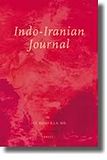Indo-Iranian Journal 52,1 (2009)
Verfasst von pw am Do, 10/15/2009 - 18:07.
Indo-Iranian Journal
Indo-Iranian Journal / Editors-in-Chief: Hans Bakker ... - Leiden : Brill.
Erscheinungsverlauf: 1.1957 -
ISSN 0019-7246 (Print-Ausgabe)
ISSN 1572-8536 (Online-Ausgabe)
Notiz: Seit 2009 erscheint das Indo-Iranian Journal bei Brill, früher: 's-Gravenhage : Mouton; Dordrecht [u.a.] : Reidel; Dordrecht : Kluwer [-2004]; Dordrecht : Springer [2005-2008]. Vergleiche den Flyer (PDF-Datei).
URL: Brill
Inhalt: 52,1 (2009)
- Darin enthalten:
- Granoff, Phyllis: „Other People's Stories: Haribhadra and the Decapitation of Brahmā“. - In: Indo-Iranian Journal. - 52 (2009), No. 1, S. 1-14.
DOI: 10.1163/001972409X445799 [alternativer Link]
Abstract: This paper explores the relevance of Jain sources for an understanding of the development of Śaiva myths. It proposes that Haribhadra's Dhūrtākhyāna offers the earliest version of the popular story of Śiva decapitating Brahmā. Comparing the version in the Dhūrtākhyāna with those in two early Śaiva sources, the early Skanda Purāna and the Brahmayāmalatantra, the paper seeks to understand the role of Visnu in the story and the development of the myth as a sectarian Śaiva story.
- Hunter, Thomas M.: „Yati, a Structural Principle in Old Javanese Versification“. - In: Indo-Iranian Journal. - 52 (2009), No. 1, S. 15-66.
DOI: 10.1163/001972409X445807 [alternativer Link]
Abstract: The principle of yati, divisions of the metrical arrangement of the quantitative meters of Sanskrit at line-end or at specified points internal to the line (pada), has often been likened to caesura in meters of the European tradition, and in the Indian tradition to a "break in recitation". However, in a principled study of the subject Pollock (1977) has shown that when line-internal yati is specified for one of the quantitative meters it is in fact linked to the arrangement of syntactic units within the line, and not to any suprasegmental aspect of versification, like intonation or the control of phrasing in terms of units of 'breath'. Based on this reasoning Pollock has been able to demonsrate a progression in the Indian tradition from "monotonic" uses of yati in Aśvaghosa, through the effects of "suspension" achieved by Kālidāsa and a movement towards "dissonance" in the works of later stylists like Bhavabhūti Rājaśekhara, Bhattanārāyana, Murāri and Bilhana, where a drive towards transcendence of the constraints of yati is very much in evidence. Given that the majority of meters of the Old Javanese kakawin genre are based on the quantitative meters of the Indian Kāvya, it is natural to suppose that line-internal yati may have been preserved in some of the Old Javanese quantitative meters. This study is devoted to an examination of this question for a selection of the Indian quantitative meters adopted for use in the kakawin, and for a further set of Indo-Javanese meters that follow the isosyllabic requirements of the Indian system, but were developed by Javanese stylists of the kakawin. Special attention is given to the meter Śārdūlavikrīdita, a meter important in Pollock's (1977) study of yati in the Indian tradition and also of great popularity in the Javano-Balinese tradition, and to the Indo-Javanese meter Jagaddhita.
- Book Reviews. - In: Indo-Iranian Journal. - 52 (2009), No. 1, S. 67-95
Ähnlich
- Indo tetsugaku bukkyōgaku ronshū 2014 - 2
- JICPBS 18 (2014)
- Zeitschrift für Indologie und Südasienstudien 2013 -- 30
- ARIRIAB 17 (2013) Supplement
- ARIRIAB 17 (2013)
- MSS 2013 - Heft 67,1
- Berliner Indologische Studien 21 (2013)
- Bulletin d'études indiennes 2012 - No. 30
- Bulletin d'études indiennes 2010-2011 - No. 28-29
- Acta Tibetica et Buddhica 2013 - 6

